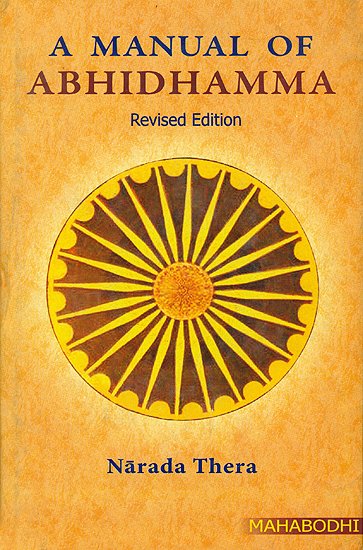Abhidhamma in Daily Life (by Ashin Janakabhivamsa)
by Ashin Janakabhivamsa | 66,666 words
English translation of "Abhidhamma in Daily Life" by Professor Ko Lay. Revised by Sayadaw U Silananda, International Theravada Buddhist Missionary University, Yangon, 1999...
Part 1 - What Is Kamma?
Kamma Means Action or deed. Kamma is of three kinds: thought, word and physical action.
Whatever you do with your limbs is kaya kamma (physical deed). Take for instance killing some being or giving charity, etc.
Verbal kamma means the words that you utter. Imperatives such as “Kill that animal” or “Offer alms to the monk”, are verbal kamma. Other forms of exhortations, lying, preaching, all fall into this category.
Mental kamma means the thoughts that occur in your mind, short of physical action and utterances by mouth. Evil thoughts such as “How I wish all property were mine” are mental kamma. Pity, compassion, sympathy, appreciative joy, practicing bhávaná meditation are also different forms of mental kamma.
The Culprit
The three forms of kamma do not occur automatically. For instance, in the act of killing the hand gets hold of the dagger. There is bound to be a prompting force makes you to utter certain words. While you are asleep there occurs no mental kamma even though many units of consciousness are arising. We now come to the conclusion therefore, that there must be a force, a potency which is different from the basic mind; and this force, is the culprit of the three kamma actions. Just as there is always a culprit in every crime, there is a potency or a force that impels three forms of deeds.
Cetana is the Culprit
The culprit which prompts the three kamma actions is nothing but the mental concomitant, cetana cetasika which occurs in the mind-continuum of beings. This cetana is the busiest, the most active of all cetasikas. Because cetana impels to perform a certain deed, because cetana is responsible for the completion of every kamma action, cetana is commonly called kamma.
Note:
The prominence of cetana among cittas and cetasikas and the role of cetana as the culprit of all kamma actions can be found in the chapter on CETASIKA where cetana is explained in detail.
Consciousness That Is Not Noticeable
Through practical experience you find some cittas and cetasikas are prominent while some are not. Some cittas do not show themselves while you are asleep even though the mind continuum is in the process. When you are wide awake too, you unmindfully see, hear, smell or touch, the eye-consciousness, ear-consciousness, etc. that arise are not clearly noticeable; as you ponder about this and that absent-mindedly, sense-objects come to the mind only unwittingly. It is due to the prompting of wholesome or unwholesome cetana volition, that physical or verbal actions take place; but when the impulsive force of each cetana accompanying the consciousness that arise is weak no action results. Such volitions without any force of impulsion (javana) to complete certain acts occur quite numerously in the course of a day.
Prominent Akusala Cetana
When you have a strong will to kill someone, the dosa javana citta and cetana also become very strong and overwhelming. Your thoughts are occupied with plans to carry out the murder. Likewise if you are too overwhelmed by evil thoughts of sensual pleasures you develop intense greed or lust in your mind and your body becomes aroused and active. At such times when actions, words and thoughts are all intent on evil deeds, the volition inside you is also very powerful evil. These evil volitions are very dynamic impulses known as akusala javana cetana and are prominent and quite noticeable when observed carefully vis-à-vis the normal trend of thoughts.
Prominent Kusala Cetana
Moral and virtuous volitions are called kusala cetana are very active when you are keeping uposatha Síla (Sabbath), when you are looking after elderly person, while discussing the Dhamma, while meditating bhávaná kamatthana and while abstaining from immoral action. This kusala javana cetana is very potent and dynamic, and so your actions, words and thoughts also become correspondingly active and dynamic.
The Lingering Potency Effect of Kamma on the Body-continuum
These prominent akusala javana cittas (impulses) are collectively termed kamma. They come into being, and then disappear but their might, influence and attributes do not disappear. They remain, as if embedded in the body-continuum to produce effects presently or later. In the body-continuum countless units of consciousness arise and pass away incessantly. Out of these the weak, inconspicuous cittas will leave no impression at all while the strong, eminent cittas leave their potent attributes in the body-continuum. For example children of ordinary common parents do not feel the lingering influences of their parents after their death, while children of notable parents do so. When notable worthy parents die their children remain perceptibly under the forceful influence of their departed parents.
Kamma Force Continues in the Continuum of Khandha
In the plant kingdom, we observe the seeds of fruit bearing plants have genetic power to bear flowers and fruits of the same species. This fruit-bearing gene is present in every stage of their species, i.e., seedlings, sprouts, full-grown trees, fruits and seeds. Though we cannot describe this genetic power, we are definitely sure of its presence. Similarly in the continuum of five khandhas (aggregates of existence) rupa and nama come into being and disappear in constant succession up to the time of cuti citta (death consciousness). The kammic forces follow in hot pursuit all along till the time of death. Even after death the forces of kamma continue to have effect on the next life. These latent forces follow on to the embryonic stage (the moment of conception) of the next life, and so on to yet another existence.
Note:
Here, mention of the forces of kamma actions strictly mean the dynamic forces of your past deeds and not anything material.
